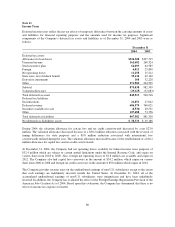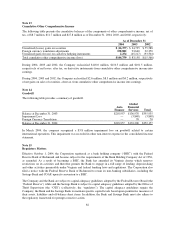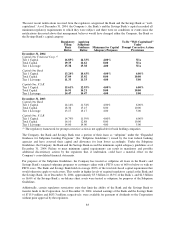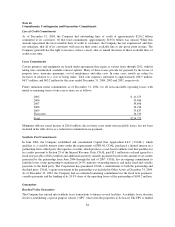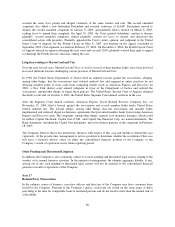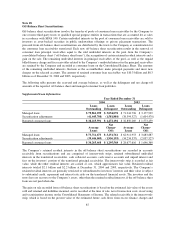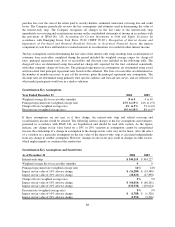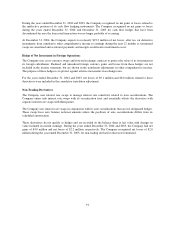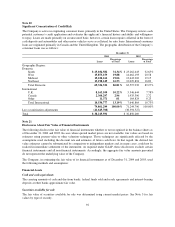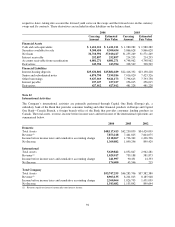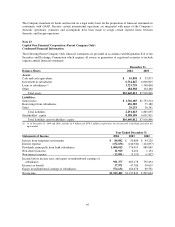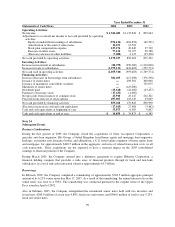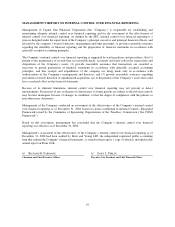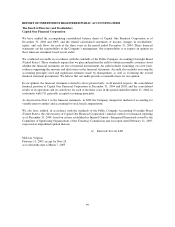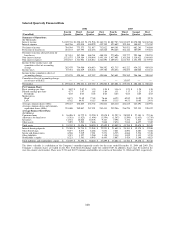Capital One 2004 Annual Report Download - page 113
Download and view the complete annual report
Please find page 113 of the 2004 Capital One annual report below. You can navigate through the pages in the report by either clicking on the pages listed below, or by using the keyword search tool below to find specific information within the annual report.The Company periodically uses interest rate swaps as part of its interest rate risk management strategy. Interest
rate swaps generally involve the exchange of fixed and variable rate interest payments between two parties, based
on a common notional principal amount and maturity date. As a result of interest rate fluctuations, hedged assets
and liabilities will appreciate or depreciate in market value. To the extent that there is a high degree of correlation
between the hedged asset or liability and the derivative instrument, the income or loss generated will generally
offset the effect of this unrealized appreciation or depreciation.
The Company’s foreign currency denominated assets and liabilities expose it to foreign currency exchange risk.
The Company enters into various foreign exchange derivative contracts for managing foreign currency exchange
risk. Changes in the fair value of the derivative instrument effectively offset the related foreign exchange gains or
losses on the items to which they are designated.
The Company has non-trading derivatives that do not qualify as hedges. These derivatives are carried at fair
value and changes in value are included in current earnings.
The Asset and Liability Management Committee, as part of that committee’s oversight of the Company’s asset/
liability and treasury functions, monitors the Company’s derivative activities. In accordance with the Company’s
asset/liability management policies, the Company reviews its risk profile on a monthly basis. The Company’s
Asset and Liability Management Committee is responsible for approving hedging strategies. The resulting
strategies are then incorporated into the Company’s overall interest rate risk management strategies.
Fair Value Hedges
The Company has entered into forward exchange contracts to hedge foreign currency denominated investments
against fluctuations in exchange rates. The purpose of the Company’s foreign currency hedging activities is to
protect the Company from the risk of adverse affects from movements in exchange rates.
During the years ended December 31, 2004 and 2003, the Company recognized substantially no net gains or
losses related to the ineffective portions of its fair value hedging instruments.
Cash Flow Hedges
The Company has entered into interest rate swap agreements for the management of its interest rate risk
exposure. The interest rate swap agreements utilized by the Company effectively modify the Company’s
exposure to interest rate risk by converting floating rate debt to a fixed rate over the next seven years. The
agreements involve the receipt of floating rate amounts in exchange for fixed rate interest payments over the life
of the agreement without an exchange of underlying principal amounts. The Company had entered into interest
rate swaps and amortizing notional interest rate swaps to effectively reduce the interest rate sensitivity of
anticipated net cash flows of its interest-only strip from securitization transactions over the next two years.
During the year ended December 31, 2002, the Company terminated the interest rate swaps and amortizing
interest rate swaps that effectively reduced the interest rate sensitivity of anticipated net cash flows of its interest-
only strip from securitization transactions. These derivative fair values, net of taxes, were included in cumulative
other comprehensive income and will be amortized into interest or servicing and securitizations income over the
previous lives of the terminated swaps.
The Company has also entered into currency swaps that effectively convert fixed rate foreign currency
denominated interest receipts to fixed dollar interest receipts on foreign currency denominated assets. The
purpose of these hedges is to protect against adverse movements in exchange rates over the next two years.
The Company has entered into forward exchange contracts to reduce the Company’s sensitivity to foreign
currency exchange rate changes on its foreign currency denominated loans. The forward rate agreements allow
the Company to “lock-in” functional currency equivalent cash flows associated with the foreign currency
denominated loans.
90


